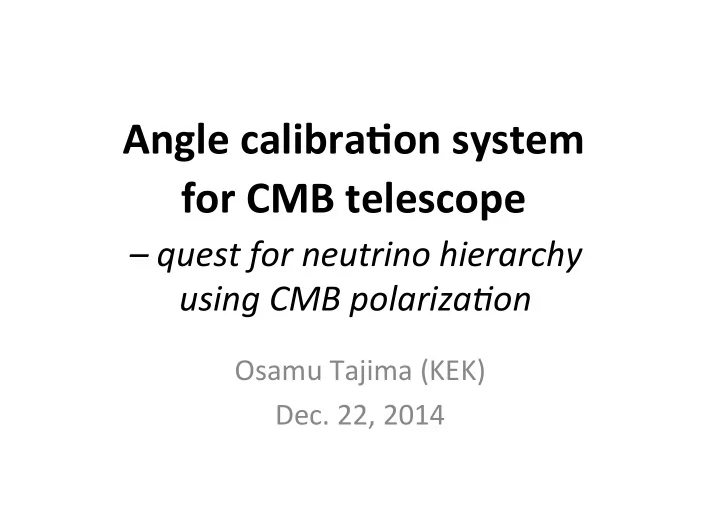

Angle&calibra,on&system&& for&CMB&telescope � –"quest"for"neutrino"hierarchy" using"CMB"polariza8on � Osamu&Tajima&(KEK)& Dec.&22,&2014 �
Neutrino&mass& via&CMB&pol. � A&journey&of&a&thousand&miles& begins&with&a&first&step& ���������� Today’s&main&topic& i.e.,&calibraFon �
Contents � • ScienFfic&goal& – Neutrino&mass&from&CMB&polarizaFon& • Instrumental&moFvaFon& – Why&calibraFon?& • Novel&cal.&for&polarizaFon&angle& – Principle& – Current&status& Need"a"pickel"for" – prospects& the"first"step"!! �
What’s&CMB&? � ��
What’s&CMB&? � It’s&Big&Bang’s&thermal&radia,on,&i.e.,&photon&!& Structure Today � ���� formation � CMB � CMB � first star � Dark age � Beginning of the Universe � Big Bang It’s"detected"as"cold" First star � ! High- ρ & High-T " radia8on,"3"K,"today"! � Dominant&interacFon& Gravity � Plasmas � among&parFcles � 380,000& 10 -36 sec � 13.8&billion& years � years � Age&of&the&Universe � ��
``CMB&today’’&is&surface&of&``Big&Bang&clouds’’ � Big$Bang$$ clouds � Clear"sky"aCer" 380,000"years � CMB � Gravita8onal"lens" effects"in"O(0.1 o )Nscale � 13.8 � ��
Gravita,onal&lens&makes& rota,on&of&polariza,onIaxis � IF$CMB$is$polarized,$ we$can$measure$the$lensing$power$ � ��
Is"CMB"polarized"? � YES,&CMB&is&polarized � Polarized&sunglasses � ScaVering&in&``clouds”&created&CMB&polarizaFon&!&& ��
Tiny non-uniformity of universe, 1/1,000%, made CMB polarization pattern � E-modes � HOT,&COLD& Symmetric"" polariza8on"" paRern"! � ������������������������������������ ������������������������������������������� � ��
Weak&lensing&makes&asymmetric& paVerns&in&CMB&polarizaFon � E [modes � Lensing "B [modes&& at&sub[deg.&scale � Rota8on"of"axis � Evalua,on&of&& Lensing&power& by& B Imode’s&power � ��� (image&credit:&ESA) �
``Voice&print”&analysis � Human&voice&is&characterized&in&Fourier&space � ���
Power&of&lens&is&also&characterized&in& Fourier&space&of&CMB&paVerns � Voice&print&spectrum � Moon&(0.5 o )& ↓ 0.2 o � � o � ↓ � ↓ B [mode&Power � Lensing& B Imodes � degree � Σ m ν & = & 0 & eV � Σ m ν & = & 0.1 & eV& Boundary"to"claim"hierarchy � degree � ↙ ︎ &InflaFon&origin � PaVern&image&map& MulFpole& l"" =&180 o /[paVern[scale] � (Here,"it’s"not"realis8c"simula8on"at"all)" ���
More&neutrino&mass& " &Less&lensing � Neutrino&is&high[speed&parFcle&(even&though&it&is&massive)& " &No&localizaFon&in&the&scale&of&galaxy&clusters � " &No&contribuFon&for&gravitaFonal&lens& � Neutrino � Lensing& poten,al � Dark$Ma=er � thickness& of&lens � Thickness$of$lens$becomes$smaller$if$neutrino$has$larger$mass � ���
Lensing&B[mode’s&power&constrains& Σν Σν & � Voice&print&spectrum � Moon&(0.5 o )& ↓ 0.2 o � � o � ↓ � ↓ B [mode&Power � Lensing& B Imodes � degree � Σ m ν & = & 0 & eV � Σ m ν & = & 0.1 & eV& Boundary"to"claim"hierarchy � degree � ↙ ︎ &InflaFon&origin � PaVern&image&map& MulFpole& l"" =&180 o /[paVern[scale] � (Here,"it’s"not"realis8c"simula8on"at"all)" ���
CMB&B[mode&observaFon,&Today � 10 3 10 2 10 1 BB /(2 � ) ( µ K 2 ) 10 0 l(l+1)C l 10 -1 DASI QUIET-Q Credit&& CBI QUIET-W 10 -2 MAXIPOL BICEP1-3yr Y.&Chinone � BOOMERanG ACTPol CAPMAP BICEP2-3yr WMAP-9yr POLARBEAR QUaD 10 -3 0 500 1000 1500 2000 2500 Multipole Moment, ell We&just&stand&at&the&start[line,& i.e.,&just&start&to&see&non[zero&power � ���
Prior&to&accumula,on&of&sta,s,cs,& instrumental&precision&should&be&good&! � ���
Why"do"we"need"pickel"? � Why&angle&calibraFon&is&important&? � E [mode&paVern � B [mode&paVern � RotaFon&of&polarizaFon&axis&makes& ``mimic& B [modes’’&from& E [modes �
Requirements&of&angle&calibraFon � E Imodes&( EE ) � D l &( µ K) � Mimic[ BB" &=& EE &×&sin 2 (2 δ )& Scale" B Imodes&( BB ) � x100"! � D l &( µ K) � 2 σ "bands � Mimic[ BB ,& δ &=&0.5 o � Σ m ν & = & 0.0 & eV � Mimic[ BB ,& δ &=&0.2 o � Σ m ν & = & 0.1 & eV � Requirements"to"claim" neutrino"hierarchy � MulFpole&=&180 o /[paVern[scale]& �
Angle&calibraFons&to&the&present � Astronomical&candle& Ar,ficial&candle& Taurus&A&& (ac,ve&signal&generator) � (supernova&remnant) � LimitaFon&by&catalog&precision& LimitaFon&of&instruments& Not&blackbody&signal& Not&blackbody&signal& δ &≈&0.5 o & � δ &≈&0.5 o & � ApJ"794:171"(2014),"A&A,"514,"A70"(2010). � arXiv"1411.1042 �
Novel&calibraFon& Just$hanging$a$metal$wire$on$top$of$telescope’s$field$of$view$$ � Passive&(not&ac,ve&control) & ! & very&stable&with&appropriate&intensity& No&need&any&instrumental&alignment "(will"explain"in"laRer"page) & & ! & Easy&&&simple,&i.e.,&robust&for&systema,cs& Blackbody&polariza,on & ! & similar&frequency&proper,es&to&CMB&
O.&Tajima& et"al. &,&J.&Low&Temp.&Phys.,& 167 ,&936&(2012).& Principle � Linear&polarizaFon& ! &Light&whose&direcFon&of&electric&field&is&aligned& Ambient&temperature&radiaFons,&mainly&come&from&the&ground&(300K) � Reflected&radiaFon&is&polarized& Axis&of&electric&field � Signal&intensity&≈20&mK&signal&in&case&of&single&wire& Wire � ���
O.&Tajima& et"al. &,&J.&Low&Temp.&Phys.,& 167 ,&936&(2012).& Proof&of&principle&in&2008 � Stokes-Q & U response ! for QUIET’ s detector � Prototype in Chicago lab., Nov. 20, 2008. ! Made by one student and me using cable & duck tape � sounds&super[easy&!! � ���
Key&technology&for&GroundBIRD&! � J."Low"Temp."Phys."176,"691"(2014)," and"Proc."SPIE"8452,"84521M"(2012). � Hanging&wire&& for&calibra,on&! �
Expected&signal&response � simulaFon � Absolute$intensity$of$signal$is$proporKonal$to$ View&from&the&top � length$of$wire$above$telescope’s$FoV$ ! $DeterminaKon$of$wireGdirecKon � Wire&alignment& is¬&necessary&! � Azimuth&=&0 o � Wire � Azimuth& Signal&response&for&each&antenna& &=&270 o � determines&each&angle&orientaFon � 90 o � Telescope& FOV � Azimuth&=&180 o � ���
Good&achievement&in&2014,&& e.g.,&proof&of&concepts& What’s&next&in&2015&?&
Sta,onary&calibra,on &by&using& Koinobori[poles&!& �
Recommend
More recommend